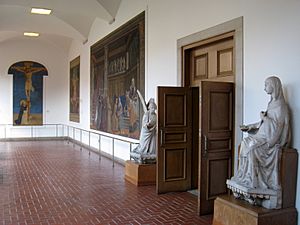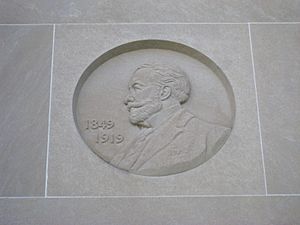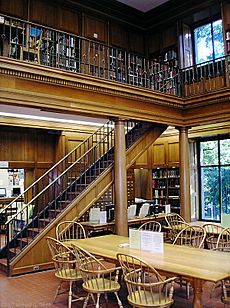Frick Fine Arts Building facts for kids
Quick facts for kids |
|
|
Henry Clay Frick Fine Arts Building
|
|
|
U.S. Historic district
Contributing property |
|

The Frick Fine Arts Building at the University of Pittsburgh sits behind the Schenley Fountain
|
|
| Built | 1962–1965 |
|---|---|
| Architect | Burton Kenneth Johnstone |
| Architectural style | Neo-Renaissance |
| Part of | Schenley Farms Historic District (ID83002213) |
| Added to NRHP | July 22, 1983 |
The Henry Clay Frick Fine Arts Building is a beautiful building on the campus of the University of Pittsburgh in Pittsburgh, Pennsylvania, United States. It looks like an old Italian Renaissance villa. This building is part of the Schenley Farms-Oakland Civic Historic District.
You can find the Frick Fine Arts Building at the southern edge of Schenley Plaza. It is across from The Carnegie Institute. This building is home to Pitt's History of Art and Architecture Department and the Studio Arts Department. It also has the Frick Fine Arts Library. Right in front of its steps is the Mary Schenley Memorial Fountain.
Contents
History of the Building
The Frick Fine Arts Building stands where the Schenley Park Casino once was. This casino was Pittsburgh's first big indoor ice skating rink and event space. It sadly burned down in December 1896.
The building itself was a gift from Helen Clay Frick (1888–1984). She was the daughter of Henry Clay Frick (1849–1919), a famous Pittsburgh businessman and art lover. Helen Clay Frick started the Fine Arts Department at the University of Pittsburgh in 1926. She continued to support it for many years. In the 1950s, she decided to create a special building just for the department. The City of Pittsburgh gave the land for this project to the university.
The building's design was inspired by the Villa Giulia in Rome, Italy. This villa was built for Pope Julius III (1487–1555). The Frick Fine Arts Building is made of white limestone and marble. It has a terracotta tile roof and a central courtyard. A tall, eight-sided dome, called an octagonal cupola, sits on top. It rises 45 feet (about 14 meters) above the ground.
Construction of the building began in 1962. It officially opened in May 1965. The building has classrooms, art studios, and an art gallery. It also includes a 200-seat auditorium and a research library.
Later, Helen Clay Frick decided to create a new art center. This was because she had different ideas about how the university should manage the art department and the new building. She then started The Frick Art Museum. This museum is located at her family home, Clayton, in Pittsburgh's Point Breeze neighborhood. Today, it is part of the Frick Art & Historical Center.
What's Inside the Building?
Today, the Frick Fine Arts Building is a busy place. It has classrooms where students learn about art. There are also art studios where students create their own artwork. The building also houses a library and art galleries. These areas are built around an open cloister, which is like a covered walkway around a courtyard.
Above the main entrance, you can see a special portrait of Henry Clay Frick. It is a low relief sculpture made of limestone by Malvina Hoffman in 1965. She was 79 years old when she took on this project. Inside the main entrance, there is a bright neon artwork by a Chinese artist named Gu Wenda.
The building also has a large auditorium with 200 seats. This space is used for many events. These include lectures, performances, and other special gatherings.
The Nicholas Lochoff Cloister
The Nicholas Lochoff Cloister is a beautiful part of the Frick Fine Arts Building. It features large paintings that are copies of famous Italian masterpieces. These copies were ordered in 1911 by the Moscow Museum of Fine Arts. A painter named Nicholas Lochoff created them.
Lochoff worked very slowly and carefully. Only a few paintings were finished and sent to Russia before the Russian Revolution of 1917. Because of the new government, Lochoff could not go back to Russia. He had to sell his paintings. Some were bought by Harvard University and the Frick Art Reference Library in New York. Later, Helen Clay Frick bought the entire collection after Lochoff passed away.
In 2003, these paintings were carefully cleaned and restored. The cloister also has beautiful white marble copies of 14th-century Annunciation figures. These sculptures were made by Alceo Dossena.
The Frick Fine Arts Library
The Frick Fine Arts Library is located inside the Frick Fine Arts Building. This library has two floors. It holds a large collection of books and resources for students and researchers. These materials are used by the History of Art and Architecture and Studio Arts Departments.
The library has over 90,000 books. It also receives more than 350 different art journals. This makes it one of the top 10 fine art libraries in the country. The library's reading room is very special. It has beautiful wood paneling and cabinets made by Italian craftspeople. These are decorated with gold leaf.
The library also features wrought iron railings on its balconies. The floor is made of terracotta tiles. There are maple tables with matching chairs. Tall windows offer lovely views of Schenley Park. A special message on the wall honors Henry Clay Frick.
The University Arts Gallery

The University Arts Gallery has a permanent collection of art. This collection includes prints and graphic works from the 16th to the 20th centuries. The gallery also hosts new art shows regularly. These shows are put on by the Department of the History of Art and Architecture.
Some important pieces in the collection include many prints by Jacques Callot and Gertrude Quastler. There are also 16th to 18th-century drawings. The gallery has a collection of 19th and 20th-century photographs. You can also see Japanese prints, Asian ceramics, and portraits. There are also paintings related to Pittsburgh by artists like Hetzel, Gorson, and Kane.
Gallery
-
The Spanish War memorial is a copy of The Hiker (1925) by Allen Newman and sits on the left side of Frick Fine Arts















